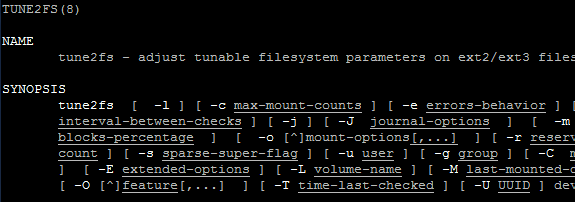Tune2fs Quick Tips
What is tune2fs ?
tune2fs adjusts tunable filesystem parameters on a Linux second extended filesystem.
Tune2fs brings the ability to modify various parameters on a file system volume that may not be the best or require some changes to reflect the needs of the environment. One example is Ubuntu: by default Ubuntu verifies file system integrity every 33 mounts/bootups or every 120 days(whichever comes first), while well intended the defaults may not be the best on a test or development system which may be subject to frequent reboots. Tune2fs is easy to understand, I will walk you through what I consider to be some of the most common uses for tune2fs.
More Information
You can always consult the man pages for more information. Just use:
$ man tune2fs
Change integrity amount and time
I tend to boot Ubuntu more than 33 times a month, which is why I always increase the number of mounts.
$ sudo tune2fs -c 120 -i 3m /dev/sdb1
tune2fs 1.40.8 (13-Mar-2008)
Setting maximal mount count to 120
Setting interval between checks to 7776000 seconds
- c max_mount_count This option is responsible for the number of mounts before the integrity check is done. - i interval-between-checks This option is responsible for the mounts of days the system should wait before performing an integrity check. d = days | w = weeks | m = months, in this example the check is to be performed every 3 months -i 3M.
Disable file system integrity check
While dangerous some people may opt to disable checks all at once.
$ sudo tune2fs -i 0 /dev/sda1
tune2fs 1.40.8 (13-Mar-2008)
Setting interval between checks to 0 seconds
-i 0 - This option disables checks based on time of the file system. Be careful the system will no longer perform integrity check after this options is selected.
Change the name of a volume
Changing the volume label name may be useful for personal labeling porpuses such as changing the name of a portable drive. Use the -l parameter to list the name of the filesystem superblock.
$ sudo tune2fs -l /dev/sda1 | grep volume
Filesystem volume name: /home/user
Capital -L parameter will change the volume-label name. In this example I am changing the name from /home/user to myhome.
$ sudo tune2fs -L myhome /dev/sda1
tune2fs 1.40.8 (13-Mar-2008)
Verify the new name change.
$ sudo tune2fs -l /dev/sda1 | grep volume
Filesystem volume name: myhome
Display file system superblock information
Lots of valuable information.
$ sudo tune2fs -l /dev/sdb1
tune2fs 1.40.8 (13-Mar-2008)
Filesystem volume name: Last mounted on: Filesystem UUID: f060d692-53fd-4180-811c-f20bcf7f24d0
Filesystem magic number: 0xEF53
Filesystem revision #: 1 (dynamic)
Filesystem features: has_journal ext_attr resize_inode dir_index filetype n eeds_recovery sparse_super large_file
Filesystem flags: signed_directory_hash
Default mount options: (none)
Filesystem state: clean
Errors behavior: Continue
Filesystem OS type: Linux
Inode count: 3932160
Block count: 15727627
Reserved block count: 786381
Free blocks: 15557651
Free inodes: 3932146
First block: 0
Block size: 4096
Fragment size: 4096
Reserved GDT blocks: 1020
Blocks per group: 32768
Fragments per group: 32768
Inodes per group: 8192
Inode blocks per group: 256
Filesystem created: Sun May 9 00:43:38 2010
Last mount time: Sun May 9 01:05:38 2010
Last write time: Sun May 9 01:05:38 2010
Mount count: 2
Maximum mount count: 33
Last checked: Sun May 9 00:43:38 2010
Check interval: 15552000 (6 months)
Next check after: Fri Nov 5 00:43:38 2010
Reserved blocks uid: 0 (user root)
Reserved blocks gid: 0 (group root)
First inode: 11
Inode size: 128
Journal inode: 8
Default directory hash: tea
Directory Hash Seed: 949c1e9b-19b3-437f-be23-05b14a671d3a
Journal backup: inode blocks
linux, tune2fs, ubuntu — May 10, 2010
